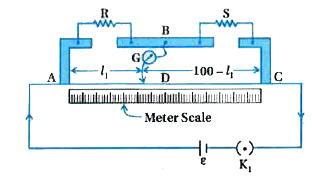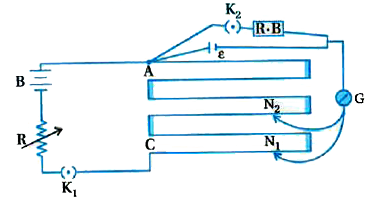Complete Solutions to SECTION [A] QUESTIONS - ANSWERS (INTRODUCTION ) of chapter CURRENT ELECTRICITY of Class 12 book with complete answers and questions
| Class 12 | PHYSICS |
| Chapter | CURRENT ELECTRICITY |
| KUMAR PRAKASHAN | SECTION [A] QUESTIONS - ANSWERS (INTRODUCTION ) |
| Number Of Questions | 53 |
| Academic Year | 2023-24 |
Explain how current is formed. Give suitable example.
View SolutionBy giving explanation of electric current, define current and its SI unit.
View SolutionHow current is formed in conductors ?
View SolutionWhy current is not formed in solid conductors in absence of electric field ?
View SolutionExplain current formed in solid conductors in presence of external electric field.
View SolutionWrite and explain Ohm's law.
View SolutionWhat is electrical resistance ? Its value depend on which factors ?
View SolutionWhat is resistivity ? Write its unit. On what factors do resistivity depend? (AU India - 2011)
View SolutionWhat is conductivity ? Its value depend on which factors ? Write its unit and dimension.
View SolutionWhat is conductivity ? Its value depend on which factors ? Write its unit and dimension.
View SolutionWhat is current density ? Derive Ohm's law in form of current density?
View SolutionExplain drift of electron and drift velocity. Derive equation of current in term of cross-section of conductor.
View SolutionObtain the equation of resistivity of metal .
View SolutionWhy resistivity of metal decreases with increase in temperature..
View SolutionExplain mobility of conductor and derive equation of mobility.
View SolutionDerive equa1ion of mobility in terms of relaxation time `(tau)`. Wrile its unit.
View SolutionDerive equation of mobility in terms of electric current.
View SolutionWrite limitations of Ohm's law.
View SolutionExplain classification of material on basis of resistivity.
View SolutionWrite information of resistors used in laboratory.
View SolutionExplain colour code to determine value of carbon film resistors,
View SolutionFind resistance value of carbon resistors shown below.
View SolutionHow resistivity of material depend on temperature. Write empirical formula .
View SolutionDraw resistivity `rarr` temperature `(rho rarr T)` graph for metals , alloys and semiconductor.
View SolutionExplain qualitative dependence of resistivity with temperature.
View SolutionExplain electrical energy and power.
View SolutionExplain power produced in electrical circuit.
View SolutionFor reduce in Ohmic loss transmission of electric power at very far distance of electric power is done at very high voltage ?
View SolutionWhich device is used to transmit voltage over large distances?
View SolutionHow resistors can be connected in different ways ?
View SolutionWhat is parallel connection of resistors ? Derive equation of equivalent resistance in parallel connection.
View SolutionExplain series connection of resistors. Derive equation of equivalent resistance `(R_(S))`.
View SolutionFor three resistors of different value connected in series obtain equation of equivalent resistance. From this write equation of n resistors connected in series.
View SolutionWhat is parallel connection of resistors ? Derive equation of equivalent resistance in parallel connection.
View SolutionObtain the expression for the equivalent resistance for 3 resistors connected in parallel and also write the expression of equivalent resistance for connection of' `n' resistors.
View SolutionFor mixed connection shown in figure derive equation of equivalent resistance.
View SolutionWrite difference between Series and Parallel connection of resistors.
View SolutionExplain cell, emf and internal resistance. Derive relation between potential difference emf and internal resistance.
View SolutionWhy the combination of cell is done ? Write it's method
View SolutionWhat is called series connection of cell ? Derive equation of equivalent emf of two cell with emf `epsilon_(1) and epsilon_(2)` connected in series.
View SolutionWhat is parallel connections of cells? Derive the equivalent equation of parallel connections of two cells.
View SolutionExplain 'Mixed Connection' of cells and derive an expression for its equivalent emf and current.
View SolutionDefine network, junction (branch point), loop.
View SolutionWrite necessary facts to understand Kirchhoff's laws.
View SolutionWrite and explain kirchhoff's first law (junction law).
View SolutionWrite and explain Kirchhoff's second law (Loop rule).
View SolutionWrite and explain Kirchhoff's second law (Loop rule).
View SolutionWhat is Wheatstonc hridge ? Explain its principle.
View SolutionExplain construction of meter bridge used in laboratory.
View SolutionExplain how value of unknown resistor can be obtained by using meter bridge.

View SolutionWhat is potentiometer ? Explain principle of potentiometer.
View SolutionExplain comparison of emf of two cell by using potentiometer with necessary diagiam.
View SolutionExplain method to measure internal resistance of cell by using potentiometer.

View Solution
SECTION [A] QUESTIONS - ANSWERS (INTRODUCTION ) questions and complete solutions for chapter CURRENT ELECTRICITY of KUMAR PRAKASHAN KENDRA PHYSICS (GUJRATI ENGLISH) of Class 12
All Exercises from KUMAR PRAKASHAN Class 12 PHYSICS CURRENT ELECTRICITY
- SECTION C (LONG ANSWER TYPE QUESTIONS )
- SECTION C (MULTIPLE CHOICE QUESTIONS (MORE THAN ONE OPTIONS))
- SECTION C (SHORT ANSWER TYPE QUESTIONS )
- SECTION C (VERY SHORT ANSWER TYPE QUESTIONS)
- SECTION C NCERT EXEMPLAR SOLUTION (MULTIPLE CHOICE QUESTIONS (MCQs))
- SECTION [A] TRY YOURSELF
- SECTION [A] QUESTIONS - ANSWERS (INTRODUCTION )
- SECTION [B] (NUMERICAL FROM .DARPAN. BASED ON TEXTBOOK)
- SECTION [B] (NUMERICAL FROM TEXTUAL EXERCISE)
- SECTION [B] (NUMERICAL)
- SECTION [B] NUMERICALS (NUMERICAL FROM TEXTUAL ILLUSTRATIONS)
- SECTION [D] MULTIPLE CHOICE QUESTIONS (MCQs) (MCQs ASKED IN AIIMS)
- SECTION [D] MULTIPLE CHOICE QUESTIONS (MCQs) (MCQs ASKED IN BOARD EXAM AND GUJCET)
- SECTION [D] MULTIPLE CHOICE QUESTIONS (MCQs) (MCQs ASKED IN CBSE-PMT, AIPMT, NEET)
- SECTION [D] MULTIPLE CHOICE QUESTIONS (MCQs) (MCQs ASKED IN COMPETITIVE EXAMS)
- SECTION [D] MULTIPLE CHOICE QUESTIONS (MCQs) (MCQs FROM .DARPAN. BASED ON TEXTBOOK)